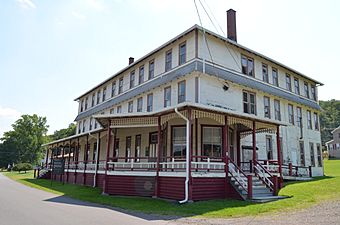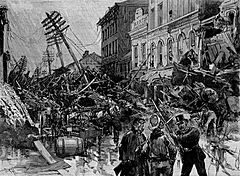South Fork Fishing and Hunting Club facts for kids
The South Fork Fishing and Hunting Club was a group of very rich men and their families who owned a private vacation spot in the mountains of Pennsylvania. This club was near South Fork, Pennsylvania, and had a large lake called Lake Conemaugh. They also owned the South Fork Dam, which held back the lake's water.
On May 31, 1889, after many days of heavy rain, the dam broke. This caused a huge flood known as the Johnstown Flood. About 14.3 million tons of water rushed down the valley, destroying towns along the Little Conemaugh River. The water flowed about 12 miles downstream to Johnstown, Pennsylvania.
At the time, this was the worst disaster in U.S. history. Clara Barton and the new American Red Cross helped the victims. About 2,209 people died in the flood. Even though many people blamed the club, they were never found legally responsible for the damage. The club closed down in 1904.
Contents
The Dam and Club's Story
The South Fork Dam was an earthen dam, meaning it was made of earth and rocks. It was first built between 1838 and 1853 by the state of Pennsylvania. Its purpose was to hold water for a canal system in Johnstown. Later, the state sold the dam, and it was sold again to private owners.
In 1880, a businessman named Benjamin Franklin Ruff had an idea for a summer retreat. He bought the old dam and the abandoned lake area. Ruff then convinced Henry Clay Frick, a very wealthy and powerful man from Pittsburgh, to join him. Frick helped bring together other rich leaders from Pittsburgh's steel and railroad industries to form the South Fork Fishing and Hunting Club.
The club named the lake Lake Conemaugh. It was about two miles long, one mile wide, and 60 feet deep near the dam. The lake could hold a massive 14.3 million tons of water. When full, it covered over 400 acres. The dam itself was 72 feet high and 931 feet long.
Even though the dam was well-built at first, it had problems. It had failed once before in 1862. Over the years, the club did not take good care of it. Between 1881 and 1889, the dam often leaked, and workers just patched it with mud and straw. These problems later helped cause the dam to break on May 31, 1889.
Major Problems with the Dam
Before the club bought the dam, important drain pipes were removed and sold for scrap metal. This meant there was no easy way to lower the lake's water level if repairs were needed. Benjamin Ruff, who was not an engineer, oversaw the dam's repairs. However, he did not fix the problem of not being able to drain the lake.
The five large iron pipes, each two feet wide, used to let water out in a controlled way. Without them, it was impossible to properly drain the lake for repairs. The club also changed the dam area for their fun activities. They made the top of the dam flatter to create a road across it. This made the dam lower, only a few feet above the water at its lowest point.
To make things worse, the club put screens across the spillway. The spillway was a channel meant to let extra water flow out safely. These screens were supposed to keep fish in the lake, but they got clogged with tree branches and other trash. This stopped water from flowing out, putting more pressure on the dam.
Daniel Johnson Morrell, a club member, was very worried about the dam's safety. He tried to warn club officials, especially Benjamin Ruff. Morrell even had his own engineers inspect the dam. He offered to help pay for repairs, but his warnings and offers were ignored. Morrell died four years before the flood he tried to prevent.
The dam had not completely broken since 1862. Despite the leaks and other warning signs, the dam held until May 1889. At the time of the flood, Colonel Elias Unger was the club's president. Benjamin Ruff, the club's founder, had died several years earlier.
After the flood, the American Society of Civil Engineers investigated why the dam broke. However, later research suggests their report was delayed and changed. A book published in 2018, Johnstown's Flood of 1889 - Power Over Truth and the Science Behind the Disaster, talks about this modern investigation.
Club Members
The South Fork Fishing and Hunting Club had many important and wealthy members. Some of the first members, brought together by Henry Clay Frick, included Benjamin Ruff, Charles J. Clarke, and Henry C. Yeager.
Some well-known members of the club were:
- Andrew Carnegie – A very rich businessman and a major giver to charities.
- Henry Clay Frick – A powerful industrialist and art collector.
- Philander C. Knox – A lawyer and politician who became a U.S. Senator and Secretary of State.
- Andrew W. Mellon – A banker, industrialist, and art collector who served as Secretary of the Treasury.
- Daniel Johnson Morrell – The general manager of the Cambria Iron Company, who tried to warn the club about the dam.
- Robert Pitcairn – A railroad executive for the Pennsylvania Railroad.
- Samuel Rea – An engineer who later became president of the Pennsylvania Railroad.
The Johnstown Flood
After many days of heavy rain, the dam broke on May 31, 1889. A massive wave of water rushed downstream, destroying several towns. When it hit Johnstown, 2,209 people died. The flood also caused about $17 million in damage, which would be around $473 million today. This event became known as the Johnstown Flood, or locally, the "Great Flood."
People had heard rumors for years that the dam might break. Maybe because of this, the warnings sent to Johnstown by telegram on the day of the disaster were not taken seriously.
When news of the dam's failure reached Pittsburgh, Henry Clay Frick and other club members quickly formed a relief committee. They wanted to help the flood victims. They also decided not to talk publicly about the club or the flood. This plan worked. Club lawyers Philander C. Knox and James Hay Reed successfully fought off four lawsuits against the club and its members. No one who sued the club received money for damages.
In the years after the flood, many people blamed the club members. They had bought and repaired the dam for their vacation spot but did not take proper care of it. Because of this, the dam was not strong enough to hold the extra water from the heavy rains. Even with this evidence, the club members were never held legally responsible. Their lawyers argued that the dam's failure was an "Act of God," meaning a natural disaster. This outcome helped change laws later, so that people could be held responsible for damage caused by dangerous things on their land, even if they weren't careless.
Even though the club was not found legally responsible, many individual members did help. Henry Clay Frick and about half of the club members donated thousands of dollars to help Johnstown. After the flood, Andrew Carnegie, a famous club member, built a new library for the town. Today, this building is owned by the Johnstown Area Heritage Association and houses the Flood Museum.
What Happened Next
On February 5, 1904, a newspaper called The Cambria Freeman reported that the South Fork Fishing and Hunting Club would soon be gone. The club planned to sell everything left in its clubhouse.
The newspaper said:
The South Fork Hunting and Fishing Club, owners of the Conemaugh Reservoir at the time of the Great Flood, will soon pass out of history as an organization with the sale of all its personal effects remaining in the clubhouse at the reservoir site. Auctioneer George Harshberger has announced that the sale will take place on Thursday, the 25th inst., at the clubhouse, when the entire furnishings will be disposed of at auction.
In the list to be disposed of are fifty bedroom suites, many yards of carpet, silverware and table ware with the club monogram engraved thereon and many odd pieces of furniture and bric-a-brac. At the time of the Great Flood the club house was handsomely furnished and was fully equipped to care for at least 200 guests. During the summer of 1889 the clubhouse remained open but has since been occupied only by a caretaker.
South Fork Fishing and Hunting Club Historic District
The Johnstown Flood National Memorial wanted to take care of the club's property. This would help them tell the story of the Johnstown Flood better. In 1986, the South Fork Fishing and Hunting Club Historic District was named a national historic district. This means it's an important historical place.
The district includes eight buildings that are still standing from the club. These include the main clubhouse and six smaller cottages. They show popular building styles from the late 1800s, like Stick/Eastlake, Gothic Revival, and Queen Anne styles.





